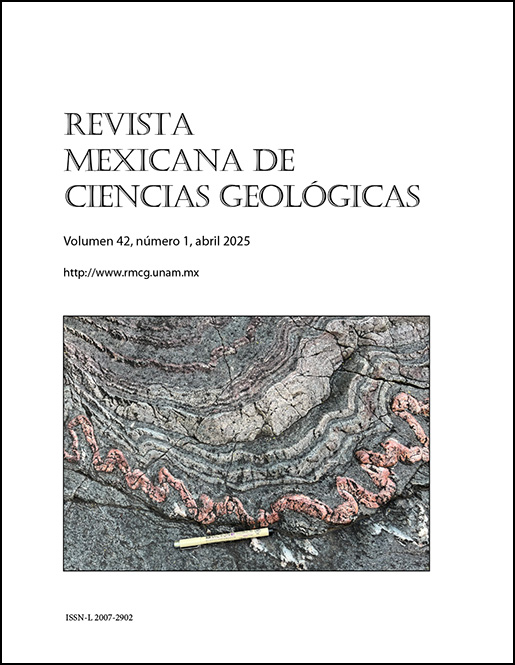Abstract
Changes in vegetation and environmental history for the last 3200 years at Laguna Cementerio, Xcalak, Quintana Roo were identified using fossil pollen and geochemical analyses of a 1.5 m depth sediment core. Changes in abundance and composition of Rhizophora mangle, Conocarpus erectus, Avicennia germinans, and Laguncularia racemosa allowed to infer changes in hydrological variability. At the beginning of the 3200 cal yr BP moist conditions were exhibited. Dominant vegetation was tropical forest, mainly composed of Moraceae, Fabaceae, Euphorbiaceae, Rubiaceae, and Bursera simaruba. During this period, mangroves were dominated by Avicennia germinans along with the presence of foraminifera. The first record of Z. mays around 850 B.C. (2800 cal yr BP) allowed the identification of agricultural activities close to the study area from the Middle Preclassic to the Late Classic. The dominant mangrove species was C. erectus, suggesting strong changes in the hydrological variability. Two drought periods were identified around 1700 and 850 cal yr BP, respectively, with the Ca/Σ (Ti, Fe, Al) curve. The drought at 1700 cal BP may be associated with changes in sea surface temperatures (SST) and sea surface salinity (SSS) that affect the strength of the Caribbean Low-Level Jet causing a decrease in the amount of rainfall for Mesoamerica. During this same period, the highest reduction of tropical forest was observed, changing the landscape to a more open vegetation that allowed the deposit of Pinus sp. The drought that occurred around 850 cal yr BP corresponds to the Terminal Classic Period. Further comparison with other climate proxy records from the region and Circum-Caribbean area suggests that the Terminal Classic Droughts were alternated with wet periods. Around 700 cal yr BP, moist conditions returned and allowed the recovery of the tropical forest. This study contributes to new evidence of changes experienced in Laguna Cementerio during the last 3200 cal yr BP, an area that has been poorly studied from a paleoenvironmental point of view.
References
Álvarez, M. (1954). Exploración geológica preliminar del rio Hondo, Quintana Roo, México. Boletín de la Asociación Mexicana de Geólogos Petroleros, 5(5-6), 207–213
Aragón-Moreno, A. A., Islebe, G. A., & Torrescano-Valle, N. (2012). A ˜3800-Yr, high resolution record of vegetation and climate change on the North Coast of the Yucatan Peninsula. Review of Paleobotany and Palynology, 178, 35–42. https://doi.org/10.1016/j.revpalbo.2012.04.002
Aragón-Moreno, A. A., Islebe, G. A., Roy, P. D., Torrescano-Valle, N., & Mueller, A. D., (2018a). Climate forcings on vegetation of the southeastern Yucatán Peninsula (Mexico) during the middle to late Holocene: Palaeogeography, Palaeoclimatology, Palaeoecology, 495, 214–226. https://doi.org/10.1016/j.palaeo.2018.01.014
Aragón-Moreno, A., Islebe, G., Torrescano-Valle, N., & Arellano-Verdejo, J., (2018b) Middle and late Holocene mangrove dynamics of the Yucatan Peninsula, Mexico. Journal of South American Earth Sciences, 85, 307–311. https://doi.org/10.1016/j.jsames.2018.05.015
Aragón-Moreno, A. A., Islebe, G. A., Torrescano-Valle, N., Hernandez-Arana, H., Carrillo, A., & Friedel, R. (2024). Mangrove dynamics driven by Late Holocene drought at Laguna Bacalar, Mexico. Quaternary Environments and Human, 2, 100023. https://doi.org/10.1016/j.qeh.2024.100023
Bautista, F., & Palacio, G. (2011). Parte III. Regionalización edáfica del territorio de México. Capítulo 24. Península de Yucatán. En P., Krasilnikov, F.J., Jiménez, T., Reyna, & N.E., García, (eds), Geografía de Suelos de México (355–406 pp). Universidad Nacional Autónoma de México.
Bautista, F., Palacio-Aponte, G., Quintana, P., & Zinck, J.A. (2011). Spatial distribution and development of soils in tropical karst areas from the Peninsula of Yucatan, Mexico. Geomorphology, 135(3-4), 308–321. https://doi.org/10.1016/j.geomorph.2011.02.014
Bertran, P., Bonnissent, D., Imbert, D., Lozouet, P., Serrand, N., & Stouvenot, C. (2004). Paleoclimat des Petites Antilles depuis 4000 BP:l’enregistrement de la lagune de Grand-Case a Saint-Martin. C.R. Geoscience, 336, 1501–1510. https://doi.org/10.1016/j.crte.2004.09.009
Birks, H. J. B. (2019). Contributions of Quaternary botany to modern ecology and biogeography: Plant Ecology and Diversity, 12(3-4), 189–385. https://doi.org/10.1080/17550874.2019.1646831
Blaauw, M., & Christen, J.A. (2011). Flexible paleoclimatic age-depth models using autoregressive gamma process. Bayesian Analysis, 6(3), 457–474. https://doi.org/ 10.1214/ba/1339616472
Brewer, S, Guiot J., & Barboni D. (2013). Use of Pollen as Climate Proxies, in A. E., Scott Mock C. J. (eds), Encyclopedia of Quaternary Science. (pp. 805-815)Elsevier, Oxford. https://doi.org/10.1016/B978-0-444-53643-3.00180-1
Can-Canales, C., Islebe, G., Carrillo, A., Torrescano-Valle, N., & Aragón-Moreno, A. (2023). Fungal spores in Caribbean mangrove sediments, dataset from southeastern Mexico. Data in Brief, 51, 109631. https://doi.org/10.1016/j.dib.2023.109631
Carrillo-Bastos, A. (2008). Variación climática y ecológica durante el Holoceno Medio-Tardío en la Península de Yucatán, un enfoque geo-espacial. [Tesis de Maestría] El Colegio de la Frontera Sur.
Carrillo-Bastos, A., Islebe, G. A., Torrescano-Valle, N., & González, N. E., (2010). Holocene vegetation and climate history of central Quintana Roo, Yucatán Península, Mexico. Review of Palaeobotany and Palynology, 160, 189–196. https://doi.org/10.1016/j.revpalbo.2010.02.013.
Carrillo-Bastos, A., Islebe, G.A., & Torrescano-Valle N. (2013). 3800 Years of Quantitative Precipitation Reconstruction from the Northwest Yucatan Peninsula. PLoS ONE, 8(12). https://doi.org/10.1371/journal.pone.0084333
Chevalier M., Basil A.S., Davis, O. H., Heikki, S, Brian, M., Chase, K. G., Terri, L., Richard, J. T., Finsinger, W., Guiot, J., Kühl, N., Maezumi S. Y., Tipton, J.R., Carter, V. A., Brussel, T., Phelps L.N., Dawson, A., Zanon, M., Vallé, F., Nolan, C., Mauri, A., de Vernal, A., Izumi, K., Holmström, L., Marsicek, J., Goring, S., Sommer, P.S., Chaput M., & Kupriyanov, D., (2020). Pollen-based climate reconstruction techniques for late Quaternary studies. Earth-Science Reviews, 210, 103384. https://doi.org/10.1016/j.earscirev.2020.103384
Cook, K., & Vizy, E. (2010). Hydrodynamics of the Caribbean Low-Level Jet and Its Relationship to Precipitation. Journal of Climate, 23, 1477–1494. https://doi.org/10.1175/2009JCLI3210.1
Comisión Nacional de Áreas Naturales Protegidas (CONANP) (2004). Programa de Manejo Parque Nacional Arrecifes de Xcalak, México. Disponible en http://www.conanp.gob.mx/que_hacemos/pdf/programas_manejo/Xcalak_ok.pdf, (consultado: 10/11/2024).
Conroy, J. L., Overpeck, J. T., Cole, J. E., Shanahan, T. M., & Kannan M. S. (2008). Holocene changes in eastern tropical Pacific climate inferred from a Galapagos Lake sediment record. Quaternary Science Reviews, 27(11-12), 1166–1180. https://doi.org/10.1016/j.quascirev.2008.02.015
Curtis, J. H., Hodell, D. A., & Brenner, M. (1996). Climate variability on the Yucatan Peninsula (Mexico) during the past 3500 yr, and implications for Maya cultural evolution. Quaternary Research, 46(1), 37–47. https://doi.org/10.1006/qres.1996.0042
Ellison, J. C. (2008). Long-term retrospection on mangrove development using sediment cores and pollen analysis: A review. Aquatic Botany, 89(2), 93–104. https://doi.org/10.1016/j.aquabot.2008.02.007
Escarraga-Paredes, D., Torrescano-Valle, N., & Islebe, G. (2014). Análisis de la relación vegetación-lluvia de polen actual de las comunidades vegetales en el noroeste de la península de Yucatán, México. Polibotánica, 38, 27–52.
Faegri, K., & Iversen, J. (1989). Textbook of pollen analysis (4th ed.). En K., Faegri, P.E., Kaland, K., Krzywinski (Eds.). Chichester, John Wiley, 354 pp.
Fragoso-Servón, P., Bautista, F., Fraustro, O., & Pereira A. (2014). Características de las depresiones kárstica (forma, tamaño y densidad) a escala 1: 50,000 y sus tipos de inundación en el estado de Quintana Roo, México. Revista Mexicana de Ciencias Geológicas, 31(1), 127–137.
Friedel, T., Johanson, E. N., & Horn, S. P. (2024). Post-Conquest vegetation and fire dynamics at Laguna Carse, Costa Rica: A pollen and microscopic charcoal record. Vegetation History and Archaeobotany, 33, 595–606. https://doi.org/10.1007/s00334-023-00981-7
García, E. (1973). Modificación al sistema de clasificación climática de Koppen (Segunda Edición). Comisión Nacional para el estudio de la Biodiversidad (CONABIO), 97 pp.
Grimm, E. C. (1987). CONISS: a FORTRAN 77 program for stratigraphically constrained cluster analysis by the method on incremental sum of square. Computer & Geoscience, 13(1), 13–35. https://doi.org/10.1016/0098-3004(87)90022-7
Grimm, E. C. (2016). Tilia (v3.0.3) [software]. Illinois State Museum. Research and Collection Center, Springfield. Disponible en https://www.neotomadb.org/apps/tilia
Gutiérrez-Ayala, L. V., Torrescano-Valle, N., & Islebe, G. A. (2012). Reconstrucción paleoambiental del Holoceno Tardío de la reserva los Petenes, Península de Yucatán, México. Revista Mexicana de Ciencias Geológicas, 29(3), 749–763.
Haug, G. H., Hughen, K. A., Sigman, D. M., Peterson, L. C., & Rohl, U. (2001). Southward migration of the Intertropical Convergence Zone through the Holocene. Science, 293, 1304–1308. https://doi.org/10.1126/science.1059725
Haug, G. H., Gunther, D., Peterson, L.C., Sigman, D. M., Hughen, K. A., & Aeschlimann B. (2003). Climate and the collapse of Maya civilization. Science, 299, 1731–1735. https://doi.org/10.1126/science.1080444
Hirales-Cota, M., Espinoza-Avalos, J., Schmook, B., Ruiz-Luna, A., & Ramos-Reyes, R., (2010). Drivers of mangrove deforestation in Mahahual-Xcalak, Quintana Roo, Southeastern Mexico. Ciencias Marinas, 36(2), 147–159. https://doi.org/10.7773/cm.v36i2.165
Hodell, D., Curtis, J., Higuera-Gundy, A., Brenner, M., Jones, G., Binford, M., & Dorsey, K. T. (1991). Reconstruction of Caribbean Climate Change over the Past 10,500 Years. Nature, 352, 790–793. https://doi.org/10.1038/352790a0
Hodell, D. A., Curtis, J. H., & Brenner, M. (1995). Possible role of climate in the collapse of Classic Maya civilization. Nature, 375, 391–394. https://doi.org/10.1038/375391a0
Hodell, D. A., Brenner, M., Curtis, J. H., & Guilderson, T. (2001). Solar forcing of drought frequency in the Maya lowlands. Science, 292(5520), 1367–1370. https://doi.org/10.1126/science.1057759
Hodell, D. A., Brenner, M., & Curtis, J. H. (2005). Terminal Classic drought in the northern Maya Lowlands inferred from multiple sediment cores in Lake Chichancanab (Mexico). Quaternary Science Reviews, 24(12-13), 1413–1427. https://doi.org/10.1016/j.quascirev.2004.10.013
Hodell, D., Brenner, M., & Curtis, J. (2007). Climate and cultural history of the Northeastern Yucatan Peninsula, Quintana Roo, Mexico. Climatic Change, 83, 215–240. https://doi.org/10.1007/s10584-006-9177-4
Islebe, G., & Sánchez, O. (2002). History of late Holocene vegetation at Quintana Roo, Caribbean coast of Mexico. Plant Ecology, 160, 187–192. https://doi.org/10.1023/A:1015865932012
Islebe, G. A., Sánchez, O., Váldez-Hernandez, M., & Weissenberger, H. (2015). Distribution of vegetation types. En G. A., Islebe, S., Calmé, J. L. J., León-Cortés, B. Schmook, (eds.). Biodiversity and conservation of the Yucatán Peninsula (39–53 pp). Springer International Publishing.
Islebe, G. A., Torrescano-Valle, N., Valdez-Hernández, M., Carrillo-Bastos, A., & Aragón-Moreno, A. A. (2022). Maize and ancient Maya droughts. Scientific Reports, 12(22272), https://doi.org/10.1038/s41598-022-26761-3
Joo-Chang, J. C., Islebe, G. A., Torrescano-Valle, N. (2015). Mangrove history during middle-and late- Holocene in Pacific south-eastern Mexico. Holocene, 25(4), 651–662. https://doi.org/10.1177/0959683614566217
Leyden, B. W., Brenner, M., & Dahlin, B. H., (1998). Cultural and climatic history of Cobá, a lowland Maya city in Quintana Roo, Mexico. Quaternary Research, 49(1), 111–122. https://doi.org/10.1006/qres.1997.1941
Liu, F., Ding, J., Zeng, J., Wang, C., Wu, B., Yan, Q., He, Z., Shu, L. (2024). Mangrove sediments are environmental hotspots for pathogenic protists. Journal of Hazardous Materials, 467(133643). https://doi.org/10.1016/j.jhazmat.2024.133643
Lozano-García, Ma. Del S., & Martínez-Hernández, E. (1990). Palinología de los Tuxtlas: Especies arbóreas. Instituto de Biología, Universidad Nacional Autonoma de México, 120 pp.
Lovelock, C. E., Cahoon, D. R., Friess, D. A., Guntenspergen, G. R., Krauss, K. W., Reef, R., Rogers, K., Saunders, M. L., Sidik, F., Swales, A., Saintilan, N., Thuyen, L. X., Triet, T, (2015). The vulnerability of Indo-Pacific mangrove forests to sea-level rise. Nature, 526, 559–563. https://doi.org/10.1038/nature15538
McCloskey, T. A., Keller, G. (2009). 5000-year sedimentary record of hurricane strikes on the central coast of Belize. Quaternary International, 195(1-2), 53–68. https://doi.org/10.1016/j.quaint.2008.03.003
Malaizé, B., Bertran, P., Carbone, P., Bonnissent, D., Charlier, K., Galop, D., Imbert, D., Serrand, N., Stouvenot, Ch., & Pujol, C. (2011). Hurricanes and climate in the Caribbean during the past 3700 years BP B. The Holocene, 21(6), 911–924. https://doi.org/10.1177/0959683611400198
Mayewski, P. A., Rohling, E. E., Curt Stager, J., Karlén, W., Maasch, K. A., David Meeker, L., Meyerson, E. A., Gasse, F., van Kreveld, S., Holmgren, K., Lee-Thorp, J., Rosqvist, G., Rack, F., Staubwasser, M., Schneider, R. R., Steig, E. J. (2004). Holocene climate variability. Quaternary Research, 62(3), 243–255. https://doi.org/10.1016/j.yqres.2004.07.001
Monacci, N. M., Meier-Grünhagen, U., Finney, B. P., Behling, H., Wooller, M. J. (2009). Mangrove ecosystem changes during the Holocene at Spanish Lookout Cay, Belize. Palaeogeography, Palaeoclimatology, and Palaeoecology, 280(1-2), 37–46. https://doi.org/10.1016/j.palaeo.2009.05.013
Monacci, N.M., Meier-Grünhagen, U., Finney, B.P., Behling, H., & Wooller, M.J. (2011). Laleoecology of mangroves along the Sibun River, Belize.Quaternary Research, 76(2), 220–228. https://doi.org/10.1016/j.yqres.2011.06.001
Moy, C.M., Seltzer, G.O., Rodbell, D.T., Anderson, D.M. (2002). Variability of El Niño/Southern Oscillation activity at millennial timescales during the Holocene epoch. Nature, 420, 162–165. https://doi.org/10.1038/nature01194
Mueller, A. D., Islebe, G. A., Hillesheim, M. B., Grzesik, D. A., Anselmetti, F. S., Ariztegui, D., Brenner, M., Curtis, J. H., Hodell, D. A., & Venz, K. A. (2009). Climate drying and associated forest decline in the lowlands of northern Guatemala during the late Holocene. Quaternary Research, 71(2), 133–141. https://doi.org/10.1016/j.yqres.2008.10.002
Ordoñez-Crespo, L., & García-Rodríguez, M. (2010). Formas kársticas comunes de los cenotes del estado de Quintana Roo (México). M+A Revista electrónica de Medio Ambiente, 9, 15–35.
Palacios-Chávez, R., Ludlow-Wiechers, B., & Villanueva-Gutiérrez, R. (1991). Flora palinológica de la Reserva de la Biosfera de Sian Ka ́an, Quintana Roo, México. Centro de Investigaciones de Quintana Roo.
Phuphumirat W., Zetter R., Hofmann,C. C., Ferguson, D. K. (2015). Pollen degradation in mangrove sediments: A short-term experiment. Review of Palaeobotany and Palynology, 221, 106–116. https://doi.org/10.1016/j.revpalbo.2015.06.004
Punwong, P., Sritrairat, S., Selby, K., Marchant, R., Pumijumnong, N., & Traiperm, P. (2018). An 800-year record of mangrove dynamics and human activities in the upper Gulf of Thailand. Vegetation History and Archaeobotany, 27, 535–549. https://doi.org/10.1007/s00334-017-0651-x
Quiroz-Jiménez, J. D., & Roy, P. D. (2017). Evaluation of geochemical data by two different XRF spectometers in sediments from the Santiaguillo Basin (State of Durango, Mexico). Geofísica Internacional, 56(3), 305–315. https://doi.org/10.22201/igeof.00167169p.2017.56.3.1819
R Core Team (2023). R: A language and environment for statistical computing [software]. R Foundation for statistical computing, Vienna, Austria, https://www.R-project.org
Reimer, P. J., Augustin, W. E. N., Bard, E., Bayliss, A., Blackwell, P. G., Ramsey, C. B., Butzin, M., Cheng, H., Edwards, R. L., Friedrich, M., Grootes, P. M., Guilderson, T. P., Hajdas, I., Hearton, T. J. Hogg, A. G., Hughen, K. A., Kromer, B., Manning, S. W., Muscheler, R., Palmer, J. G., Pearson, C., van der Plicht, J., Reimer, R. W., Richards, D. A., Scott, E. M., Southon, J. R., Turney, C. S. M., Wacher, L., Adolphi, F., Buntgen, U., Capano, M., Fahrni, S. M., Fogtmann-Schulz, A., Friedrich, R., Kohler, P., Kudsk, S., Miyake, F., Olsen, J., Reinig, F., Sakamoto, M., Sookdeo, A., & Talamo, S. (2020). The IntCal20 Northern Hemisphere Radiocarbon Age Calibration Curve (0–55 cal kBP). Radiocarbon, 62(4), 725–757. https://doi.org/10.1017/RDC.2020.41
Roberts, N., 2014. The Holocene. John Wiley and Sons, 378 pp.
Roy, P. D., Torrescano-Valle, N., Islebe, G. A., & Gutiérrez‐Ayala, L. V., (2017). Late Holocene hydroclimate of the western Yucatan Peninsula (Mexico). Journal of Quaternary Science, 32(8), 1112–1120. https://doi.org/10.1002/jqs.2988
Roy, P. D., Torrescano-Valle, N., Escarraga-Paredes, D. S., Vela-Pelaez, A. A., Lozano-Santacruz, R. (2018). Comparison of elemental concentration in near-surface late Holocene sediments and precipitation regimes of the Yucatán Peninsula (Mexico): a preliminary study. Boletín Geológico y Minero, 129(4), 693–706. https://doi.org/10.21701/bolgeomin.129.4.006
Sefton, J. P., & Woodroffe, S. A. (2021) Assessing the use of mangrove pollen as a quantitative sea-level indicator on Mahé, Seychelles. Journal of Quaternary Science, 36(2), 311–323. https://doi.org/10.1002/jqs.3272
Taylor, S. R., & McLennan S. M., (1985). The continental crust: its composition and evolution. Oxford, Blackwell Scientific Publications, 312 pp.
Torrescano-Valle N. (2007). Reconstrucción paleoambiental del Holoceno Medio-Tardío en la parte centro-sur de la Península de Yucatán, México [Tesis de Doctorado]. El Colegio de la Frontera Sur, 94 pp.
Torrescano-Valle, N., & Islebe, G. A. (2006). Tropical Forest and mangrove history of southeastern Mexico: a 5000-yr pollen record and implications for sea level rise. Vegetation History and Archaeobotany, 15, 191–195. https://doi.org/10.1007/s00334-005-0007-9
Torrescano-Valle, N., & Islebe, G. (2012). Mangroves of Southeastern Mexico: Paleoecology and Conservation. The open Geography Journal, 5, 6–15. https://doi.org/10.2174/1874923201205010006
Torrescano-Valle, N., Folan, W., Yanez-Montalvo, A., & Gunn, J. (2023). Climate and agricultural history from the Petén Campechano in the Late Holocene Maya lowlands of southern Mexico. Vegetation History and Archaeobotany, 32, 387–403. https://doi.org/10.1007/s00334-023-00914-4
Urrego, L. E., Bernal, G., & Polanía, J. (2009). Comparison of pollen distribution patterns in surface sediments of a Colombian Caribbean mangrove with geomorphology and vegetation. Review of Palaeobotany and Palynology, 156(3-4), 358–375. https://doi.org/10.1016/j.revpalbo.2009.04.004
Walker, M., Gibbard, P., Head, M. J., Berkelhammer, M., Bjorck, S., Cheng, H., Cwynar L.C., Fisher, D., Gkinis, V., Long, A., Lowe, J., Newnham, R., Rasmussen, S.O., & Weiss H. (2019). Formal Subdivision of the Holocene Series/Epoch: A Summary: Journal of the Geological Society of India, 93, 135–141. https://doi.org/10.1007/s12594-019-1141-9
Woodroffe, C. D., Beech, M. R., & Gagan, M. K., (2003). Mid-late Holocene El Niño variability in the equatorial Pacific from coral microatolls. Geophysical Research Letters, 30(7), 1358. https://doi.org/10.1029/2002GL015868
Wooller, M. J, Morgan, R., Fowell, S., Behling, H., Fogel, M. (2007). A multiproxy peat record of Holocene mangrove paleoecology from Twin Cays, Belize. The Holocene, 17(8), 1129-1139. https://doi.org/10.1177/0959683607082553
Wooller, M. J., Behling, H., Guerrero, J. L., Jantz, N., Zweigert, M. E. (2009). Late Holocene hydrologic and vegetation changes at Turneffe Atoll, Belize, compared with records from mainland Central America and Mexico. Palaios, 24(9-10), 650–665. https://doi.org/10.2110/palo.2009.p09-036r
Wu, H. C., Felis, T., Scholz, D., Giry C., Kölling, M., Jochum K. P., Scheffers S. R. (2017). Changes to Yucatán Peninsula precipitation associated with salinity and temperature extremes of the Caribbean Sea during the Maya civilization collapse. Scientific Reports, 7, (15825). https://doi.org/10.1038/s41598-017-15942-0
Vidal-Zepeda, R., (2005). Las regiones climáticas de México. UNAM, México, Colecciones de Temas Selectos de Geografía de México, temas selectos de Geografía de México, Investigaciones Geográficas. Universidad Nacional de México, Instituto de Geografía, 212 pp.
Xiao J., Wu J., B. Liang W., Nakamura T., Liu B., Inouchi Y. (2006). Holocene Climate changes in the monsoon & Arid transition reflected by carbon concentration in Daihai Lake of Inner Mongolia. The Holocene 16(4), 551–560. https://doi.org/10.1191/0959683606hl950rp
Yan, K., Wang, Cl., Mischke, S., Wang, J. V., Shen, L. J., Yu, X. C, Meng, L. Y. (2021). Major and trace-element geochemistry of Late Cretaceous clastic rocks in the Jitai Basin, southeast China. Scientific Reports, 11, 13846. https://doi.org/10.1038/s41598-021-93125-8

This work is licensed under a Creative Commons Attribution 4.0 International License.
Copyright (c) 2025 Chloe Brynie Ulanie Rosas, Alicia Carrillo-Bastos, Claudia González-Salvatierra, Alejandro Antonio Aragón-Moreno, Gerald Islebe












